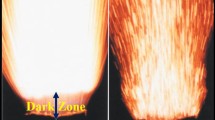Abstract
The fabrication of carbon 3D-nano/microstructures based on the nanostructure deposition from gas phase on the surface of specially treated carbon fibres is proposed as an initial preparative stage to produce a carbonaceous scaffold for hybrid (adsorption-absorption) hydrogen storage materials. This materials design approach is focused toward the hybrids/composites, which could combine the capacity of compounds consuming hydrogen chemically with high specific surface area of systems adsorbing hydrogen intensively by physisorption. The fullerene molecules in the reaction zone can serve not only as a source of carbon pair (arc discharge) but as the catalyst of synthesis of carbon nanostructures (pyrolysis of hydrocarbons). In the present work the carbon fibres were impregnated by fullerene solution in toluene that catalyzed the process of carbon nanotubes growth at the fibres surface.
Access this chapter
Tax calculation will be finalised at checkout
Purchases are for personal use only
Similar content being viewed by others
References
Ross DK (2006) Hydrogen storage: the major technological barrier to the development of hydrogen fuel cell cars. Vacuum 80:1084–1089
Hydrogen, Fuel Cells and Infrastructure Technologies Program. Multi-Year Research, Development and demonstration plan. Planned program activities for 2005–2015. U.S. Department of Energy. 3.3 Hydrogen Storage, pp 1–9
Ross DK (2008) In: Walker G (ed) Solid state hydrogen storage: materials and chemistry. Woodhead Publishing, Cambridge, pp 135–170
Shabalin IL, Keens SG, Mileeva ZhA et al (2009) Hydrogen materials science and chemistry of carbon nanomaterials. The use of neutron scattering techniques for investigation of hydrogen storage systems. In: Schur DV, Zaginaichenko SYu, Veziroglu TN, Skorokhod VV (eds) Proceedings of the 11th International Conference (ICHMS’2009). AHEU, Kyiv, pp 44–45
Seifi M, Ross DK, Giannasi A (2007) Raman characterization of single-walled carbon nanotubes produced by the catalytic pyrolysis of methane. Carbon 45:1871–1879
Georgiev PA, Ross DK, Albers P et al (2006) The rotational and translational dynamics of molecular hydrogen physisorbed in activated carbon: a direct probe of microporosity and hydrogen storage performance. Carbon 44:2724–2738
Lee J-Y, Wood CD, Bradshaw D et al (2006) Hydrogen adsorption in microporous hypercrosslinked polymers. Chem Comm 26:2670–2672
Bull DJ, Weidner EW, Shabalin IL et al (2010) Pressure-dependant deuterium reaction pathways in the Li–N–D system: an in situ deutron diffraction study. Phys Chem Chem Phys 12:2089–2097
Schur DV, Dubovoy AG, Lysenko EA, Golovchenko TN, Zaginaichenko SYu, Savenko AF, Adeev VM, Kaverina SN (2004) Synthesis of nanotubes in the liquid phase. In: Hydrogen materials science and chemistry of carbon nanomaterials. NATO Science Series, vol II/172, pp 147–151
Schur DV, Dubovoy AG, Savenko AF, Bogolepov VA, Koval AYu, Zaginaichenko SYu, Lysenko EA (2003) Investigations into catalytic activity of LaNi5 in synthesis of carbon nanotubes. In: Proceedings of the 8th international conference “hydrogen materials science and chemistry of carbon nanomaterials”, Sudak, Crimea, 14–20 Sep 2003, pp 410–413
Bogolepov VA, Schur DV, Adeev VM, Golovchenko TN, Voronaya TV, Kotko AV, Lysenko EA (2009) Synthesis of carbon nanotubes on the surface of carbon fibers. In: Proceedings of the 11th international conference “hydrogen materials science and chemistry of carbon nanomaterials”, Yalta, Crimea, 25–31 Aug 2009, pp 406–409
Mileeva ZhA, Bogolepov VA, Schur DV, Zaginaichenko SYu, Begenev VA, Shabalin IL, Ross DK (2009) Hybrid 3D-nano/microstructures obtaining on the basis of pretreated carbon fibers. In: Proceedings of the 11th international conference “hydrogen materials science and chemistry of carbon nanomaterials”, Yalta, Crimea, 25–31 Aug 2009, pp 746–749
Author information
Authors and Affiliations
Corresponding author
Editor information
Editors and Affiliations
Rights and permissions
Copyright information
© 2011 Springer Science+Business Media B.V.
About this paper
Cite this paper
Mileeva, Z.A. et al. (2011). Carbon Nano/Microstructures for Hybrid Hydrogen Storage Based on Specially Treated Carbon Fibers. In: Zaginaichenko, S., Schur, D., Skorokhod, V., Veziroglu, A., İbrahimoğlu, B. (eds) Carbon Nanomaterials in Clean Energy Hydrogen Systems - II. NATO Science for Peace and Security Series C: Environmental Security, vol 2. Springer, Dordrecht. https://doi.org/10.1007/978-94-007-0899-0_8
Download citation
DOI: https://doi.org/10.1007/978-94-007-0899-0_8
Published:
Publisher Name: Springer, Dordrecht
Print ISBN: 978-94-007-0898-3
Online ISBN: 978-94-007-0899-0
eBook Packages: Chemistry and Materials ScienceChemistry and Material Science (R0)




